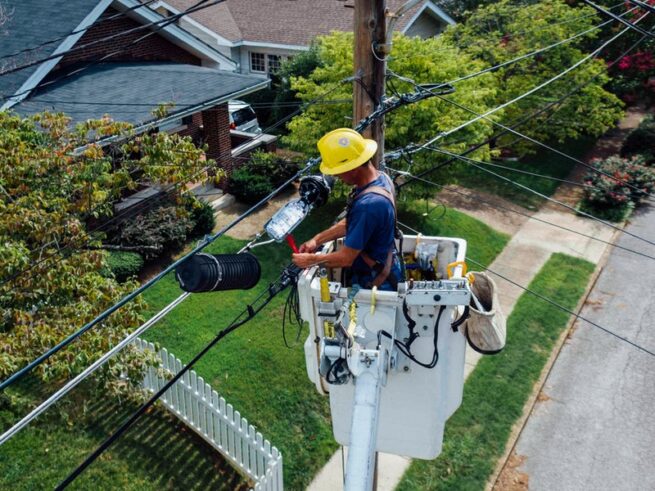There’s a mere six inches of separation between the Day Avenue duplexes, which means if they were human, they would never pass the social-distancing test.
Smooshed together like sardines, the West Coconut Grove houses would never pass the toddler test either, said Miami Commissioner Ken Russell.
“Even a toddler can see it and laugh at it even though a toddler can’t read the city zoning code,” Russell said.
The houses at 3374 and 3384 Day Avenue — one under construction, the other occupied — are in obvious violation of the required five-foot setback between property line and exterior wall, which gives 10 feet of breathing space between dwellings. The two-story duplexes have a total of 4 feet, 10 inches between them on the ground, and less than a foot separates their roof eaves. Houses built illegally close together pose fire hazards, degrade property values, inhibit drainage and destroy privacy.
Demolish the new one before it is finished and sold, say residents of the rapidly gentrifying, historically Black West Grove who spoke angrily during Thursday’s remote city commission meeting about how the duplex advances what’s come to be known as the invasion of the white cubes, which is wiping out the character of a community founded by Bahamian settlers.

But the developer of the properties is fighting back, arguing that the city approved his plans and it is unfair to force him to undo them. After the city placed a stop-construction order on 3374 Day Avenue last year, 3384 Day Investments Inc. filed a lawsuit seeking the withheld building permit.
Russell urged his fellow commissioners not to settle the lawsuit on Thursday, warning it would set a precedent that would encourage other developers salivating over marginalized neighborhoods ripe for redevelopment to get away with similar monstrosities. A commission meeting to discuss the lawsuit was scheduled for July 23 while a court hearing to push progress forward on the suit is scheduled for Friday.
“I beg you not to enter into any settlement that will leave this blatantly illegal structure standing for decades to come,” Andy Parrish told commissioners. He is president of Wind and Rain Homebuilders on Grand Avenue, and a proponent of Bahamian Village-design affordable housing in the West Grove. “Residents will know you don’t give a hoot about them or their neighborhood. You do not want your names associated with a building that when people drive down the street, they’ll wonder, ‘How did that ever get approved?’
“It’s not enough to say it was a series of errors by city zoning and building officials. Your own eyeballs tell you otherwise. It’s the result of grossly negligent actions by one or more city officials. Please in the name of justice see that this monument to greed comes down.”
Homeowner Melissa Meyer, an architectural designer who has lived in the West Grove for 28 years, has documented 40 noncompliant buildings with numerous setback and height violations as developers rush to build large, boxy, modernist homes jammed to the edges of lot lines, often adjacent to and out of scale with modest older homes or cottages shaded by the jungly foliage that is quintessential Coconut Grove.
“The developers are increasing their profits but decreasing the value of surrounding properties until they, too, get bought out,” said Meyer, who presented videotaped comments Thursday, unspooling her tape measure to show a setback violation.
“It’s stealing. It’s another example of how Black people do not have equal protection under the law. If the city doesn’t enforce its own laws, it is violating citizens’ civil rights. The identity of our neighborhoods and quality of life for future generations is at stake.”
Meyer’s persistent complaints to former city zoning director Devin Cejas resulted in the stop-work order on Day Avenue and also on a new Ohio Street house that’s been abandoned. The partially-built eyesore has become a magnet for trash and a haven for animals. Neighbors call it the “Fox Den.”

“These illegal buildings are classic cases of ask for forgiveness later,” said Miami attorney David Winker, who is representing Meyer as an Intervenor Neighbor in the lawsuit. “Developers don’t make mistakes by accident. If they can get away with building houses 6 inches apart, think about what else they’re doing.”
The proposed settlement for 3374 Day Avenue would permit the building to stand with slight modifications to it and the abutting house: Fill in windows that face each other, and prune back the eaves.
Not enough, says Russell, who opposes City Attorney Victoria Mendez’s recommendation to settle. She advised commissioners to avoid a potentially costly court battle that could end in the developer’s favor given a key “erroneous” decision by the city even though it was “based in large part on misrepresentations contained in the application,” she wrote in the settlement agreement.
“We are building a strong case that shows the city did make errors but that approval of the plans was based on deceptive statements by the developer,” said Russell, who advocates tightening the code to eliminate loopholes like bay windows that encroach over the line. “They decided it was worth the risk to try to deceive the zoning department. A settlement would only solidify the city’s reputation of allowing violations of our own code to go unchecked.”
An attorney for the real estate development company did not return phone messages, but developer Laurent Bernazzani has maintained city officials gave the green light for his plans on Day Avenue and previous projects with the same footprint. An email from Cejas reads: “After review and discussion with our legal department we have determined that 3374 Day Ave. is being constructed as to plans and compliant as to setbacks.” Under Cejas, who now works as deputy development services director for Coral Gables, the city granted permission to divide the original lot and build two structures.
Leaders of a petition drive said they’d sue the city if it agrees to the settlement, Russell said. While he’s not sure the duplex could be torn down, it should be reconstructed to make room for 10 feet of separation.
“I’d like to see the developer do the right thing so it’s an example, especially in a community of need where properties are being acquired with low bids and overdeveloped at the expense of the complete displacement of the neighbors,” Russell said. “I don’t want the city complicit in the eradication of a culture. The West Grove is surrounded by such wealth that it has a target on its back. Gentrification pressure is on in places like Little Haiti and Allapattah, and the West Grove has a toehold left.”
Winker said gentrification is accelerated by the city’s lax enforcement.

“The West Grove is more attractive to developers because it’s easy to skirt laws and that’s increased the pace of redevelopment,” he said. “It’s one thing if gentrification was happening as a natural force of the market but it’s being perverted to incentivize gentrification.”
The duplexes exist because a “unity of title” designation granted to the developer for the 10,000-square-foot lot allowed the first duplex to be built on what later became the property line of what was first considered one building site. When the city granted a release from the unified designation, the plans submitted for the second duplex on newly created Lot 2 showed compliance with the setback law because the duplex on Lot 1 was grandfathered in as if it was invisible. So the plan for Lot 2 meets the setback because it doesn’t show the building next door, explained zoning director Joseph Ruiz, who replaced Cejas. When discussing the buildings last year with the Herald, Ruiz said they are result of “a combination of mistakes and misrepresentations.” Russell said the manuever indicates “bad faith” by the developer.
Coconut Grove residents are fed up with the proliferation of hulking, charmless white cubes built to maximize square footage and sale prices while also decimating the tree canopy. And they’re spreading to other neighborhoods, Russell said.

“The cube is not an architectural design but a mathematical formula,” he said. “This makes a 5,000-square-foot lot with a new duplex on it worth $2.4 million.”
Winker and others who spoke passionately at Thursday’s meeting said it is critical that the city not give in on the Day Avenue duplexes because they are such clear examples of what’s gone wrong in the Grove.
“The developer’s job is to make money. The city’s job is to hold the developer accountable on behalf of the residents,” said Winker, who added that flouting setbacks in the age of COVID-19 is also unsafe. “Having outdoor space makes a community healthy.”






More Stories
Buying a Condo
Red, White and Blue – What Are The Timeshare Seasons?
What You Need to Know About Selling Your Condominium in Today’s Market